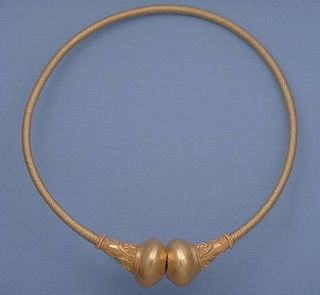
A torc, also spelled torq or torque, is a large rigid or stiff neck ring in metal, made either as a single piece or from strands twisted together. The great majority are open at the front, although some have hook and ring closures and a few have mortice and tenon locking catches to close them. Many seem designed for near-permanent wear and would have been difficult to remove.

Burton is a village in the community of Rossett in Wrexham County Borough, Wales. The hamlet of Burton Green is a separate settlement and is located around a mile northwest from Burton.

Towton is a small village and civil parish in the Selby District of North Yorkshire, England. It was historically part of the West Riding of Yorkshire until 1974.

The Yorkshire Museum is a museum in York, England. It was opened in 1830, and has five permanent collections, covering biology, geology, archaeology, numismatics and astronomy.

York Museums Trust (YMT) is the charity responsible for operating some key museums and galleries in York, England. The trust was founded in 2002 to run York's museums on behalf of the City of York Council. It has seen an increase in annual footfall of 254,000 to the venues since its foundation. In both 2016 and 2017, it saw its annual visitors numbers reach 500,000 people.

The Great Torc from Snettisham or Snettisham Great Torc is a large Iron Age torc or neck ring in electrum, from the 1st century BC. It is one of the finest pieces of early Celtic art in a distinctly British Celtic style. It is the most spectacular object in the Snettisham Hoard of torcs and other metalwork found in 1950 near the village of Snettisham in Norfolk, East Anglia. The perfectly intact torc is outstanding for its high level of craftsmanship and superb artistry. Soon after its discovery it was acquired by the British Museum.

The Bedale Hoard is a hoard of forty-eight silver and gold items dating from the late 9th to early 10th centuries AD and includes necklaces, arm-bands, a sword pommel, hacksilver and ingots. It was discovered on 22 May 2012 in a field near Bedale, North Yorkshire, by metal detectorists, and reported via the Portable Antiquities Scheme. Following a successful public funding campaign, the hoard was acquired by the Yorkshire Museum for £50,000.

The Havor hoard is an Iron Age treasure found in 1961, in Hablingbo on the Swedish island of Gotland. It consists of a large gold torc, known as the Havor Ring, along with several well-preserved bronze objects and was buried inside a Roman bronze situla in the mound surrounding a hillfort.

The Leekfrith torcs are four Iron Age gold torcs found by two hobby metal detectorists in December 2016 in a field in Leekfrith, north Staffordshire, England. The find consists of three neck torcs and a smaller bracelet, which were located in proximity to each other. They are believed to be the oldest Iron Age gold jewellery found in Britain. Subsequent archaeological examination of the area did not uncover further objects.
















